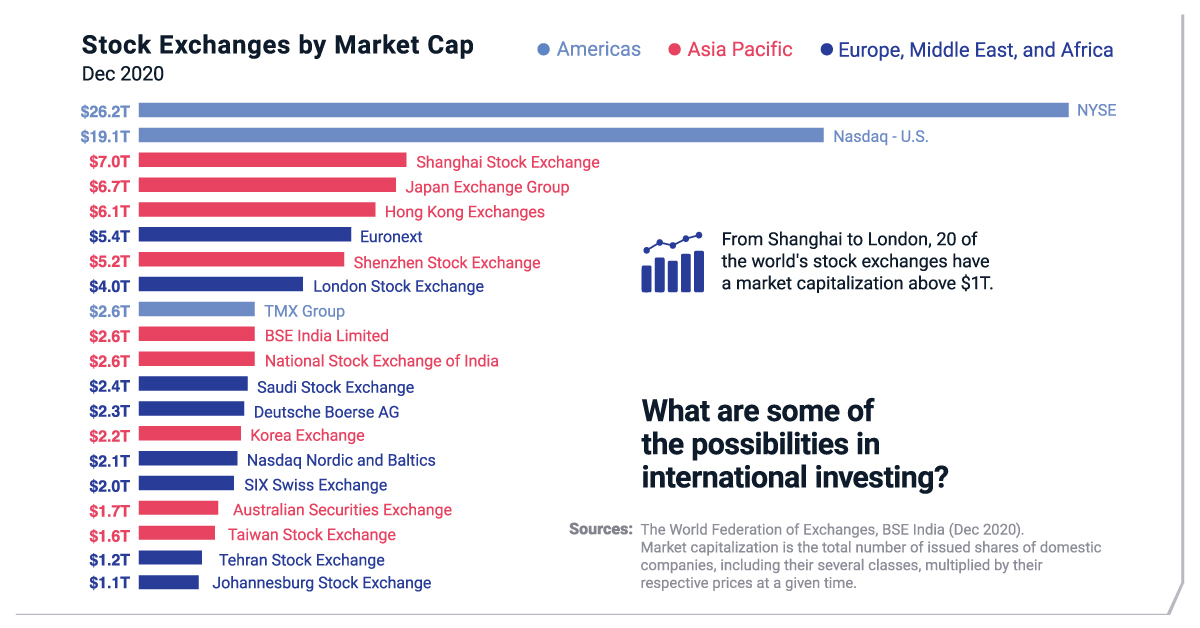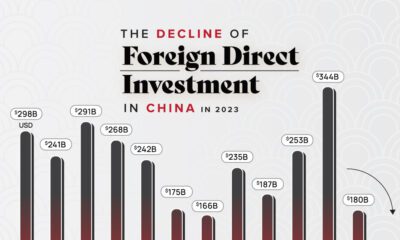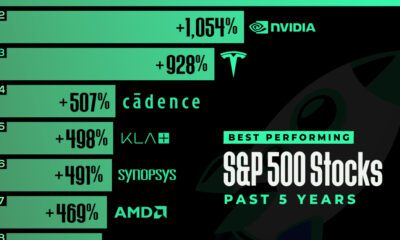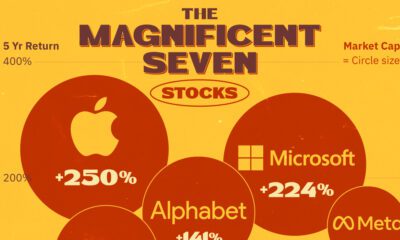Markets
A Global Perspective: The Possibilities in International Equity Investing

The Possibilities in International Equity Investing
When we’re in our comfort zones, we’re more likely to feel safe and familiar—and this same psychological effect is at play when we’re choosing where to invest. In fact, it’s widely understood that investors tend to prefer investing in their home country instead of taking a more global perspective, a behavior known as home bias.
However, investors could consider expanding their geographic exposure. From Shanghai to London, 20 of the world’s stock exchanges have a market capitalization above $1 trillion.
This infographic from MSCI highlights the possibilities in international equity investing. Let’s dive into some of the key concepts covered in the visualization.
Consider Correlations
For starters, by looking abroad, investors may be able to include markets in their portfolio that have relatively low correlation with their home market. This means the market movements are not as closely aligned, and the markets may behave differently from one another.
For instance, the U.S. has varying degrees of correlation with international stock markets. A correlation of 0 indicates there is no relationship between the market movements, while a correlation of 1 indicates that they move the exact same percentage in the same direction.
| Country | Correlation With U.S. Market |
|---|---|
| Japan | 0.11 |
| Taiwan | 0.21 |
| Korea | 0.24 |
| China | 0.43 |
| UK | 0.58 |
| France | 0.59 |
Daily correlations based on data from December 31 2015-December 31 2020.
In the past, adding less correlated markets to a portfolio has helped to reduce overall volatility.
Manage Potential Concentration Risk
Technology companies have become more dominant in major U.S. stock indexes due to their strong performance. In the MSCI USA Index, for example, the weighting of FAANG stocks has doubled from about 8% in 2019 to more than 16% in 2021.
This increased concentration means that more of the performance and risk of each index can be driven by this small number of stocks. Branching out geographically can help to reduce that concentration risk.
Access Alternative Revenue Sources
Investors that focus in the U.S. may find their exposure to revenues and potential growth from other regions is limited. For example, only 31% of the MSCI USA Index’s revenue exposure comes from areas outside North America.
On the other hand, the MSCI All Country World Index derives about 70% of its revenue exposure from regions outside North America. As investors move towards a more global portfolio, they increase their exposure to revenue and potential growth from other regions.
Gain Exposure to Economic Growth From Other Regions
While GDP growth in developed economies has been more consistent, growth in emerging markets has been higher. For example, emerging markets typically experience higher GDP growth as they transition to industrial economies with higher standards of living.
Here is historical and projected data for various regions, based on average annual GDP growth.
Historical and Projected GDP Growth by Region
| 2001-2020 | 2021P-2025P | |
|---|---|---|
| Europe | 1.45% | 2.82% |
| North America | 1.63% | 2.84% |
| Pacific | 2.52% | 2.80% |
| World | 3.33% | 4.12% |
| Emerging Markets | 5.12% | 5.10% |
Note: Projections as of April 2021. The Pacific region represents Japan, Hong Kong, Singapore, Australia, and New Zealand.
Emerging markets had GDP growth that outpaced other regions in the past, and the International Monetary Fund projects that they will continue to experience above average growth.
Increase Exposure to Innovation
Thematic investing is one way to gain exposure to innovation, and international investing is another potential method.
Innovation goes far beyond Silicon Valley, and is heating up abroad. In fact, over 70% of total R&D spending in 2018 originated outside of North America. Israel, Korea, and Taiwan were the top spenders as a percentage of GDP. By taking part in international equity investing, investors can aim to capitalize on new developments.
Access Attractive Valuations
Emerging markets have an attractive price relative to their return on equity, a measure of a stock’s profitability.
| Price to Book Value | Return on Equity | |
|---|---|---|
| U.S. | 4.4 | 13.7 |
| Emerging Markets | 2.0 | 9.2 |
| Europe & Middle East | 1.9 | 8.5 |
| Pacific | 1.6 | 6.4 |
Data as of December 2020.
Emerging markets offer the second highest return of equity of the group, at a much lower price to book value than U.S. stocks. In other words, emerging market stocks offer strong investor returns in comparison to the price paid to obtain them.
Broadening Horizons With International Equity Investing
While many investors succumb to home bias, they could consider a wider set of investment options around the world. By engaging in international equity investing, investors can:
- Aim to increase diversification and manage risk
- Take advantage of growth opportunities
- Access emerging markets
Global markets are changing. As innovation and growth accelerate outside North America, investors may want to consider new possibilities.
Markets
The European Stock Market: Attractive Valuations Offer Opportunities
On average, the European stock market has valuations that are nearly 50% lower than U.S. valuations. But how can you access the market?

European Stock Market: Attractive Valuations Offer Opportunities
Europe is known for some established brands, from L’Oréal to Louis Vuitton. However, the European stock market offers additional opportunities that may be lesser known.
The above infographic, sponsored by STOXX, outlines why investors may want to consider European stocks.
Attractive Valuations
Compared to most North American and Asian markets, European stocks offer lower or comparable valuations.
| Index | Price-to-Earnings Ratio | Price-to-Book Ratio |
|---|---|---|
| EURO STOXX 50 | 14.9 | 2.2 |
| STOXX Europe 600 | 14.4 | 2 |
| U.S. | 25.9 | 4.7 |
| Canada | 16.1 | 1.8 |
| Japan | 15.4 | 1.6 |
| Asia Pacific ex. China | 17.1 | 1.8 |
Data as of February 29, 2024. See graphic for full index names. Ratios based on trailing 12 month financials. The price to earnings ratio excludes companies with negative earnings.
On average, European valuations are nearly 50% lower than U.S. valuations, potentially offering an affordable entry point for investors.
Research also shows that lower price ratios have historically led to higher long-term returns.
Market Movements Not Closely Connected
Over the last decade, the European stock market had low-to-moderate correlation with North American and Asian equities.
The below chart shows correlations from February 2014 to February 2024. A value closer to zero indicates low correlation, while a value of one would indicate that two regions are moving in perfect unison.
| EURO STOXX 50 | STOXX EUROPE 600 | U.S. | Canada | Japan | Asia Pacific ex. China |
|
|---|---|---|---|---|---|---|
| EURO STOXX 50 | 1.00 | 0.97 | 0.55 | 0.67 | 0.24 | 0.43 |
| STOXX EUROPE 600 | 1.00 | 0.56 | 0.71 | 0.28 | 0.48 | |
| U.S. | 1.00 | 0.73 | 0.12 | 0.25 | ||
| Canada | 1.00 | 0.22 | 0.40 | |||
| Japan | 1.00 | 0.88 | ||||
| Asia Pacific ex. China | 1.00 |
Data is based on daily USD returns.
European equities had relatively independent market movements from North American and Asian markets. One contributing factor could be the differing sector weights in each market. For instance, technology makes up a quarter of the U.S. market, but health care and industrials dominate the broader European market.
Ultimately, European equities can enhance portfolio diversification and have the potential to mitigate risk for investors.
Tracking the Market
For investors interested in European equities, STOXX offers a variety of flagship indices:
| Index | Description | Market Cap |
|---|---|---|
| STOXX Europe 600 | Pan-regional, broad market | €10.5T |
| STOXX Developed Europe | Pan-regional, broad-market | €9.9T |
| STOXX Europe 600 ESG-X | Pan-regional, broad market, sustainability focus | €9.7T |
| STOXX Europe 50 | Pan-regional, blue-chip | €5.1T |
| EURO STOXX 50 | Eurozone, blue-chip | €3.5T |
Data is as of February 29, 2024. Market cap is free float, which represents the shares that are readily available for public trading on stock exchanges.
The EURO STOXX 50 tracks the Eurozone’s biggest and most traded companies. It also underlies one of the world’s largest ranges of ETFs and mutual funds. As of November 2023, there were €27.3 billion in ETFs and €23.5B in mutual fund assets under management tracking the index.
“For the past 25 years, the EURO STOXX 50 has served as an accurate, reliable and tradable representation of the Eurozone equity market.”
— Axel Lomholt, General Manager at STOXX
Partnering with STOXX to Track the European Stock Market
Are you interested in European equities? STOXX can be a valuable partner:
- Comprehensive, liquid and investable ecosystem
- European heritage, global reach
- Highly sophisticated customization capabilities
- Open architecture approach to using data
- Close partnerships with clients
- Part of ISS STOXX and Deutsche Börse Group
With a full suite of indices, STOXX can help you benchmark against the European stock market.

Learn how STOXX’s European indices offer liquid and effective market access.

-

 Economy2 days ago
Economy2 days agoEconomic Growth Forecasts for G7 and BRICS Countries in 2024
The IMF has released its economic growth forecasts for 2024. How do the G7 and BRICS countries compare?
-

 Markets1 week ago
Markets1 week agoU.S. Debt Interest Payments Reach $1 Trillion
U.S. debt interest payments have surged past the $1 trillion dollar mark, amid high interest rates and an ever-expanding debt burden.
-

 United States2 weeks ago
United States2 weeks agoRanked: The Largest U.S. Corporations by Number of Employees
We visualized the top U.S. companies by employees, revealing the massive scale of retailers like Walmart, Target, and Home Depot.
-

 Markets2 weeks ago
Markets2 weeks agoThe Top 10 States by Real GDP Growth in 2023
This graphic shows the states with the highest real GDP growth rate in 2023, largely propelled by the oil and gas boom.
-

 Markets2 weeks ago
Markets2 weeks agoRanked: The World’s Top Flight Routes, by Revenue
In this graphic, we show the highest earning flight routes globally as air travel continued to rebound in 2023.
-

 Markets3 weeks ago
Markets3 weeks agoRanked: The Most Valuable Housing Markets in America
The U.S. residential real estate market is worth a staggering $47.5 trillion. Here are the most valuable housing markets in the country.
-

 Education1 week ago
Education1 week agoHow Hard Is It to Get Into an Ivy League School?
-

 Technology2 weeks ago
Technology2 weeks agoRanked: Semiconductor Companies by Industry Revenue Share
-

 Markets2 weeks ago
Markets2 weeks agoRanked: The World’s Top Flight Routes, by Revenue
-

 Demographics2 weeks ago
Demographics2 weeks agoPopulation Projections: The World’s 6 Largest Countries in 2075
-

 Markets2 weeks ago
Markets2 weeks agoThe Top 10 States by Real GDP Growth in 2023
-

 Demographics2 weeks ago
Demographics2 weeks agoThe Smallest Gender Wage Gaps in OECD Countries
-

 Economy2 weeks ago
Economy2 weeks agoWhere U.S. Inflation Hit the Hardest in March 2024
-

 Green2 weeks ago
Green2 weeks agoTop Countries By Forest Growth Since 2001















